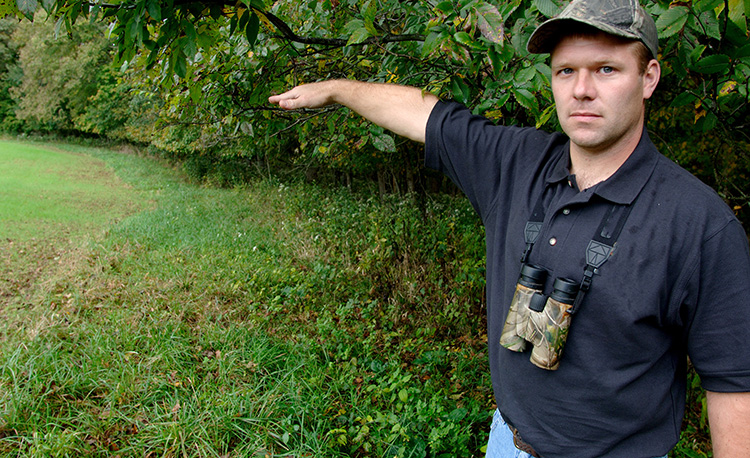Dan from Missouri asks,
Hi Bill, My question is on doe harvest. How do you determine if your property has too many does? And when is your preferred time to take them? And most importantly - Do you find that taking them off certain plots, fields, etc affects your ability to harvest mature bucks in the same areas? Much appreciated, love the content.
Bill responds,
Topic: When to Shoot Does:

If you see a distinct browse line on the trees and brush along the edges of open fields, you should start to question whether you have too many deer. This is one sign that your numbers may be directly impacting the long-term amount of browse your property can produce. Deer can literally wipe out some species of browse if there are too many of them.
Dan,
This is a very involved topic that really takes a bit of explaining. I will do my best to summarize here, but I am sure I will not cover all the dynamics of this question.
There are ways to get a very accurate count on the number of bucks and does on your property using trail cameras. Here is a link to a method endorsed by the QDMA. We did this on my farm one winter and the results were very similar to what I had guessed from many hours spent hunting the place.
So while the survey is very useful, you can often get close to the same results based on experience if you on the property enough. I focused on three things to decide whether I had too many deer. First was habitat and crop damage. Second was hunting experience and third was buck to doe ratio. I will cover them one at a time.
Habitat and Crop Damage: I wanted to be able to improve the habitat on my property which meant that I couldn’t have the deer eat everything as soon as it poked out of the ground.
I needed time for young oak trees, for example, to get tall enough that the deer weren’t nipping them off every spring. I also wanted the underbrush to flourish in the areas where we did timber stand improvement to produce lots of browse back in the timber. If you have too many deer, it is really hard to change the habitat. You can really see this in the form of browse lines that appear along the edges of open fields. These look like someone came along and cut the branches off about four feet off the ground. The deer did that. When you see browse lines that should be a yellow flag that maybe you have too many deer.
I also wanted a realistic number of acres of food plots to support the deer through the winter. That’s when they need it most for overall health. If you have too many deer (or too few food plot acres – there is a balance) your food sources will be gone well before the winter ends. I tried to supply as much food as was reasonably possible, but you can only spend so much on food plots before you feel that you are wasting money. If that is still not enough, it is time to shave the deer numbers back to fit within that food supply.
The Hunting Experience: I paid attention to how many deer I saw when hunting. I want the hunting to be enjoyable and challenging, which means that you can’t have a deer behind every bush but you do need to see at least some each time you go out. While most people think it is awesome to see tons of deer, that eventually starts to feel too easy. The adrenaline rush goes away and you start to take them for granted.
So, it is possible to have too many deer just from the standpoint of maintaining the integrity and challenge of hunting. This may not seem like a priority to most people, but I have hunted places (like the Black Hills of Wyoming and the Milk River in Montana, for example, and even some spots in the Midwest) where there are so many deer that it doesn’t feel like hunting. I never wanted my properties to be like that. Plus, if you have too many deer, it can be really tough to get to and from stands without constantly bumping into them and setting off a stampede.
Buck to Doe Ratio: I look at the number of bucks versus the number of does. My goal was always to have as many adult bucks as adult does on the farm. That may not be realistic in some states and some neighborhoods because the other hunters in the area are pounding bucks and not shooting does. In those areas, a better goal might be something like three does for each buck. The idea is to balance the sex ratio as much as possible.
There are two advantages to a balanced (or nearly balanced) ratio. First, the rut is over in one or two cycles and that results in less stress for the bucks. If they are still working to breed does into a third cycle, it is hard on them. The idea is to get the rut over as quickly as possible. The second benefit of a fast rut is the fact that you will see more buck activity because the bucks have to compete (travel) a bit more to find the next doe.
Which of the three factors is most important: Of these three elements, the most important is maintaining the deer numbers within the limits of the food supply. If there are so many deer that you can’t grow browse back in the timber (or on the edges), you have too many deer or you need to improve the habitat and food sources.
How Many to Shoot: It is really hard to shoot enough does to actually bring the population down noticeably if your neighbors aren’t also shooting them. If you decide you have too many deer but you are the only one in the area shooting does, you can probably shoot as many as possible and not shoot too many. That is the sobering reality of this challenge. It can be really hard to single-handedly get ahead of the herd growth. You will need help from your neighbors to make any real difference unless you own a lot of land.
The scientific answer to the question of how many to shoot is that you need to shoot roughly 25% of your adult does each year to keep the herd from growing. If you want to bring it down, you need to shoot more than 25%. You can estimate your number and then try to shoot 25% of that number, but just realize that there will be some that spill in from the neighboring properties during the off-season and you will have to start over again – especially if you have the best food sources around.
As I mentioned, it can be a real battle if you are the only one shooting does.
When to Shoot Them: Strictly from a genetic and biological standpoint, it is best to shoot them before the rut. That way you reduce the number of does that need to be bred, which also reduces the amount of stress on the bucks. They enter the winter in better condition. Also, in theory, if you shoot them all before the rut you are not shooting any does that were bred by your best bucks.
Unfortunately, it is really hard to shoot a good number of does before the rut. You will get some, for sure, but if your target number is more than just a handful, you are going to have to shoot them all fall in order to hit the target number. So, that is my answer. You keep shooting them until you hit your number. It is better to do that, in order to keep the herd in check, than to stop shooting them when the rut starts and not hit the target number of does harvested.
Will Shooting Does Affect Buck Hunting: This one is also tough to answer because there are many factors, way too many to get into here. But, the short answer is maybe. If you have a small property and you shoot most of the does off it, the area bucks won’t spend as much time there. But if you have a decent sized property and there are still doe family groups around during the rut, you shouldn’t see much difference in your buck hunting.
Now if you have a big property and shoot lots of does you may think the bucks will leave during the rut. That has not been my experience. Just realize that they don’t know what is happening outside their ranges. If the doe numbers drop within their range, they just travel more in that range. They don’t suddenly enlarge their range – at least I never saw that even though we flipped the buck to doe ratio and actually had more bucks than does for several years.
But, if there are more does in one part of their range than in other parts, they will naturally spend more time (but not all their time) rutting in those areas that have the most does. So, the question is not whether they will leave, it is more related to the range of the bucks and what is happening in each part of that range. If their entire range is range is on your property, you won’t see much change in buck numbers. But if bucks are ranging on and off the property you may see some difference in the number of bucks during the rut if you shoot a high number of does.
In my experience, you really need to make extreme changes to the herd before you will see noticeable changes in the number of bucks during the rut. If you are just shooting 25% of your does each year you should not see any difference in the rut.
Sorry for the long answer, but it is a very involved subject and I really only scratched the surface. Good luck. (1/4/22)
